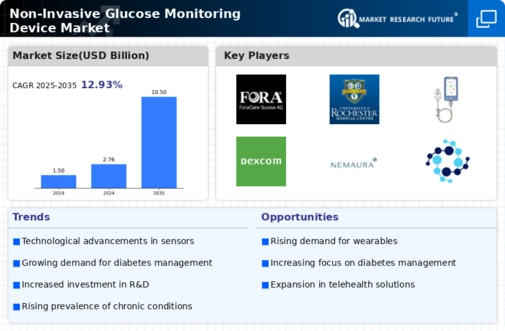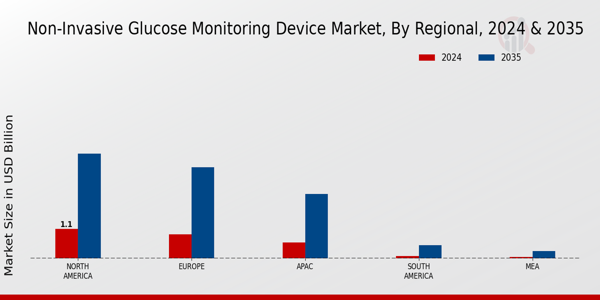Market Growth Projections
Technological Advancements
Technological innovations play a crucial role in shaping the Global Non-Invasive Glucose Monitoring Device Market Industry. Recent advancements in sensor technology, data analytics, and wearable devices have enhanced the accuracy and reliability of non-invasive glucose monitoring solutions. For instance, the integration of optical sensors and biosensors has shown potential in providing real-time glucose readings without the need for blood samples. These innovations not only improve user experience but also expand the market's reach to a broader audience. As technology continues to evolve, the industry is likely to witness increased adoption rates, further driving market growth.
Rising Prevalence of Diabetes
The increasing prevalence of diabetes globally is a primary driver for the Global Non-Invasive Glucose Monitoring Device Market Industry. With an estimated 537 million adults living with diabetes in 2021, this number is projected to rise significantly. The demand for effective glucose monitoring solutions is paramount, as traditional methods often involve discomfort and inconvenience. Non-invasive devices offer a promising alternative, potentially improving patient compliance and outcomes. As the market evolves, the industry anticipates a surge in demand, contributing to the market's projected growth from 2.76 USD Billion in 2024 to 10.5 USD Billion by 2035.
Rising Awareness and Education
Increasing awareness and education regarding diabetes management are vital drivers for the Global Non-Invasive Glucose Monitoring Device Market Industry. Health campaigns and initiatives aimed at educating the public about diabetes prevention and management have led to a greater understanding of the importance of regular glucose monitoring. As individuals become more informed about their health, the demand for non-invasive monitoring solutions is likely to rise. This heightened awareness, coupled with the convenience of non-invasive devices, positions the market for substantial growth, potentially achieving a market size of 2.76 USD Billion by 2024.
Regulatory Support and Approvals
Regulatory bodies worldwide are increasingly recognizing the importance of non-invasive glucose monitoring technologies, providing a supportive framework for the Global Non-Invasive Glucose Monitoring Device Market Industry. Recent approvals for innovative devices by agencies such as the FDA and EMA have paved the way for market entry and expansion. This regulatory support not only enhances consumer confidence but also encourages manufacturers to invest in research and development. As more non-invasive devices receive regulatory clearance, the market is poised for growth, with the potential to reach 10.5 USD Billion by 2035.
Growing Demand for Patient-Centric Solutions
The shift towards patient-centric healthcare is significantly influencing the Global Non-Invasive Glucose Monitoring Device Market Industry. Patients increasingly seek solutions that prioritize comfort, convenience, and ease of use. Non-invasive glucose monitoring devices align with these preferences, offering a painless alternative to traditional finger-prick methods. This trend is particularly evident among younger populations and tech-savvy individuals who value innovative healthcare solutions. As healthcare providers and manufacturers respond to this demand, the market is expected to expand, with projections indicating a compound annual growth rate of 12.92% from 2025 to 2035.












